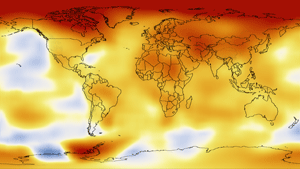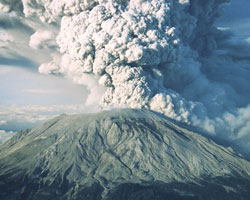Ruled Out
Many factors, such as the sun, the Earth's orbit, and sometimes even volcanic eruptions, can affect the Earth's climate. Scientists use climate models to look at all these factors and determine what is causing climate change. They find that there's only one clear explanation for what's happening now: Extra greenhouse gases in the atmosphere are warming the Earth. Learn more about climate models.
Climate Challenge!
Can you rule out natural factors as the main cause of today's climate change?
Examine the facts by clicking on the images below, and then make your decision.
Alternative version for screen reader user
The Sun
The facts: Since the 1970s, the sun has been cooling slightly. Over this same time period, the Earth has gotten warmer. Most of the warming has occurred in the lower atmosphere near the Earth's surface.
- Could the sun be responsible for today's climate change? Reveal answer
No. If the sun were the cause of climate change, the Earth's temperature would be cooling, not warming! Also, if the sun were responsible for the increased warming, it would occur throughout the entire atmosphere.
So, the sun is NOT the cause of today's climate change.
The Earth's Orbit
The facts: The way the Earth tilts on its axis and the way it circles the sun can influence the amount of the sun's energy that reaches the planet. As a result, changes in the Earth's orbit can cause the climate to change, but these changes happen very slowly, over tens to hundreds of thousands of years.
- Could the Earth's orbit be responsible for today's climate change? Reveal answer
No. Cycles in the Earth's orbit happen so slowly that they cannot account for the rapid warming we are seeing today. Also, the current position of the Earth's orbit should result in cooler temperatures, but instead, the opposite is happening—the average temperature of the Earth is getting warmer.
So, the Earth's orbit is NOT responsible for today's climate change.
Volcanoes
The facts: When volcanoes erupt, they add a small amount of greenhouse gases into the atmosphere. They also release dust, ash, and other particles called aerosols. Some volcanic explosions are so strong that they throw these aerosols high enough into the atmosphere that they block some sunlight from reaching the Earth.
- Could volcanoes be responsible for today's climate change? Reveal answer
No. Although volcanoes do add some carbon dioxide (a greenhouse gas) into the atmosphere, people add about 100 times more! The amount of carbon dioxide that comes from volcanoes has not increased, and it's not enough to cause global warming. Actually, the main way volcanoes can change the Earth's climate is by causing a temporary cooling effect. After a very large eruption, particles from the eruption can stay in the atmosphere for as long as a few years, where they block sunlight and make the planet a little bit cooler. This has happened several times in the last 40 years—most recently in 1991 with the eruption of Mount Pinatubo in the Philippines.
So, volcanic eruptions are NOT responsible for today's climate change.
A Model Approach

Scientists use models to learn more about current and future changes in the Earth's climate. A climate model is a computer program that uses math equations to describe how the land, the atmosphere, oceans, living things, and energy from the sun affect each other and the Earth's climate. Using these equations, models can predict how a change in one part of the climate system, such as increasing greenhouse gases or decreasing Arctic sea ice, will affect other parts of the Earth in the future.
Some people are concerned that climate models can't mimic how the world really works. But scientists have worked on these types of models for more than 40 years to make sure they get the most important things right. In the same way that video games have improved from simple graphics to very realistic scenery and action, climate models have improved to include details like how clouds form and where it might rain more.
Scientists test their models by comparing the results with real measurements. They only use models that have proven to be useful in understanding past and present changes in the Earth's climate, such as the global temperature changes recorded over the last century. As time goes on, climate scientists will have more and more data to work with, and computers will continue to become more and more powerful and get even better at predicting future climate change.
All the models agree that extra greenhouse gases will cause warmer temperatures, and improved models won't change this basic prediction.


